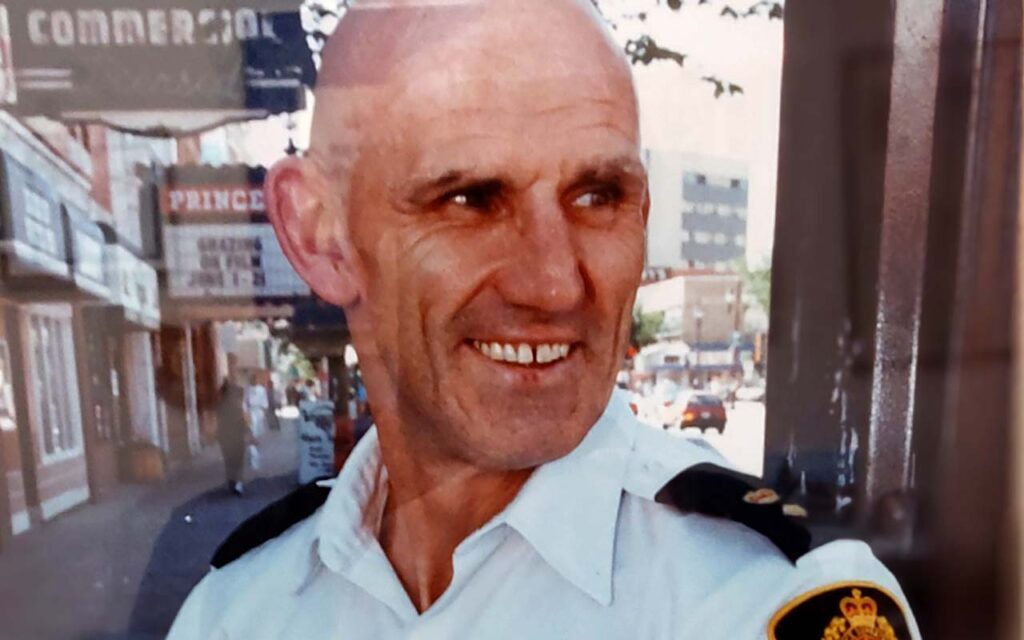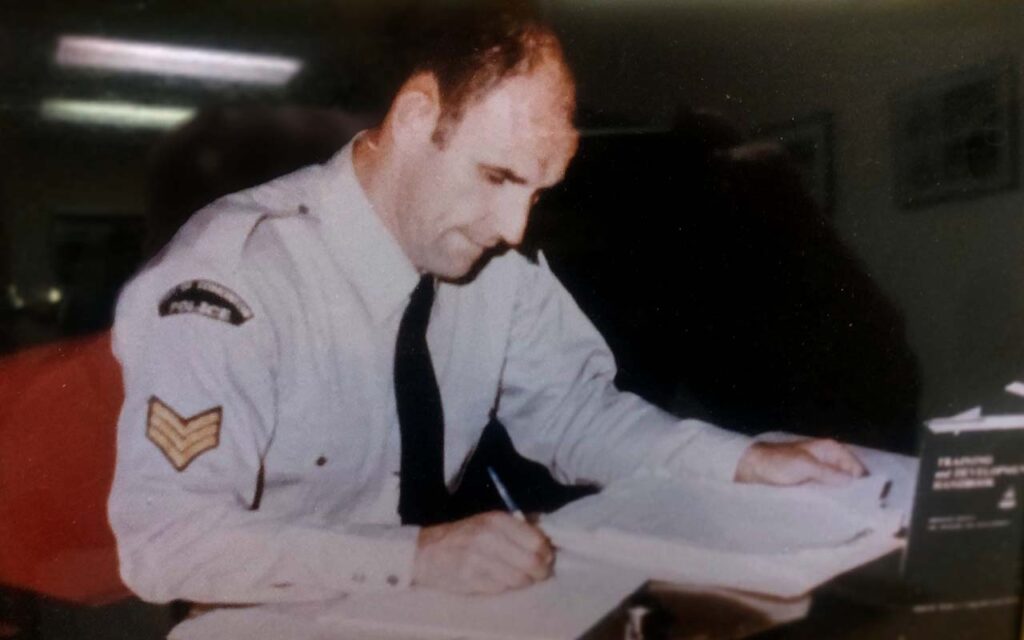Christopher Braiden was born on May 13, 1939 in England to Irish parents. The family moved to Edmonton in 1959. Braiden became a police officer in Jasper Place in 1961, which had its own police force that joined with Edmonton Police Service when JP and Edmonton amalgamated in 1964. He later became superintendent in the late ‘80s and retired in the early ‘90s. He and his wife Valerie shared some of his memories with the Jasper Place Community HIstory Project.

Q: What made you decide to pursue a career as a police officer?
CB: Well first of all, my brother was already in the police. He served in the police in Ireland and when he came to Canada he served with the Edmonton police. I couldn’t join the police in Ireland because you had to have a special education, and I left school at 14. I worked hard in a sawmill in Ireland and when I came to Canada I came because my brother came first, and he was with the Edmonton police. In those days they wouldn’t recruit two members of the same family. But also, I didn’t have the education necessary. I’d had a burning wish to become a police officer. At the time, Jasper Place had its own police forces they called them back then, not police service. The chief of police there was Rodney Stevenson at the time. I was a big strong muscular lad at the time, because I grew up strong. Even though I had little education and no whatever, I had always been a very good self education person. The Christian Brothers, while I was in that school for a while in Ireland, they were trying to brainwash us into the Catholic religion. I realized that, so I got out of school as soon as I can. But I always had been a voracious reader, and not reading fiction or anything like that, but history. So I had, in my own way, studied the role of police in a common law democracy. In the United States it’s a different kind of policing, because they’re not a common law democracy. That came from England and Britain and moved on. For that, the police served the people, not the government. Also, the police had been of course there were enough motor vehicles available now for ordinary people and what have you, so the foot patrol in policing in Edmonton and Jasper Place had been done away with years before, since they were able to have motor vehicles for all the police officers. But I started off on the beat in Jasper Place, started foot patrol in Jasper Place. As I’m saying, having read the history of police, it belonged to the community, not the government or not the military. In the United States, for instance, and many other countries, policing had become very militaristic and heavily armed. So I started the foot patrol in Jasper Place, but even then they carried side arms.
Q: After Jasper Place and Edmonton amalgamated, did you stay still predominantly in the Jasper Place area as a police officer, or were you then dispatched to other locations?
CB: They left me in Jasper Place for a while. But I remember that the police service at the time discovered how much I knew about the history of policing and what have you. So they took me in to serve in the recruit training so I could pass on my knowledge of the history of policing and what it was intended to do in our kind of culture and community. So that’s how I got into the Edmonton Police Service in I think it was ’64 or ’65.

Q: What are some memories that you have of being a police officer in Jasper Place?
CB: Walking the beat. After opening periods I would check the businesses. After closing. Because we didn’t have carry-on radios at the time, so I would check and make sure that they had closed up and everything. Walking the beat, I would walk into the bars and the hotels and just walk around where the public was allowed to go. I would walk through there and try to ensure that there was no rough behaviour going on.
Q: Did you ever do any patrolling at any special events?
CB: I’m trying to remember. I think there was some event that would welcome in summer. They would block off the roads and have cars coming through slowly, sort of a motor vehicle parade.
Valerie: Tell her about when you just walked in off the street and Rodney Stevenson interviewed you and hired you, took you down to the basement. Took him to the basement and they cobbled together a uniform for him. They cobbled together bits and pieces, including a Sam Browne, and gave him a gun and a holster. The gun was too small and it fell down through the holster and it didn’t show, so Chris stuffed a bit of newspaper in the holster, because he was proud of having a gun and being a policemen, so he wanted his gun to show.
Q: So you just walked in off the street and asked for a job as a police officer, and you got hired right away?
CB: Ya.

Q: Valerie, was there anything else?
Valerie: Just one little story that he used to tell quite often. One of the nights he was checking the doors of a little restaurant, and he could tell it had been broken into. So he went in to check things out, and he saw a piece of pie underneath one of those pie plates with the cover. He was really hungry.
CB: That was midnight shift.
Valerie: He didn’t think anybody would notice the pie missing, so he ate the pie. Then when the owner came and saw the pie gone he said to Chris, “Well, whoever’s fingerprints is on that pie dish stole the pie.” It was Chris’ fingerprints, so I think he tried to wash them off or something. It all turned out in the end okay, but he was petrified that he’d be found as the culprit stealing the pie. I can’t think of anything else. All this is second hand to me, because I didn’t meet Chris until 1967 and by then he was in the Edmonton Police Service. By then his brother had moved on to Victoria.
This post is part of the Jasper Place Community History Project’s Community Stories series. These are stories about current and former community members presented mostly in their own words. We have not fact-checked these stories. As a result, there may be some discrepancies concerning dates, locations, spellings of names, and other details.
The series is curated by Paula E. Kirman and Colette Lebeuf.


